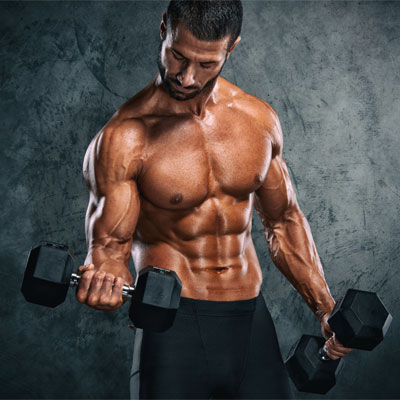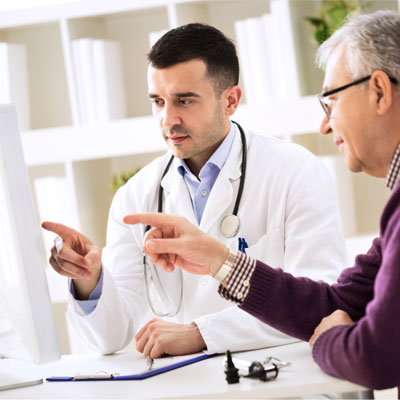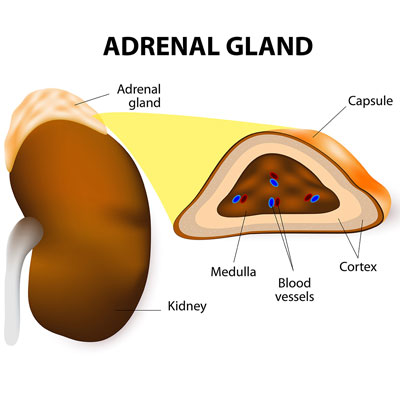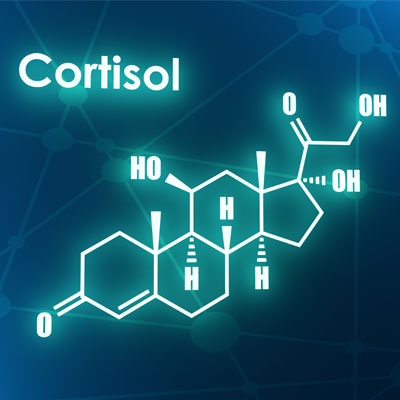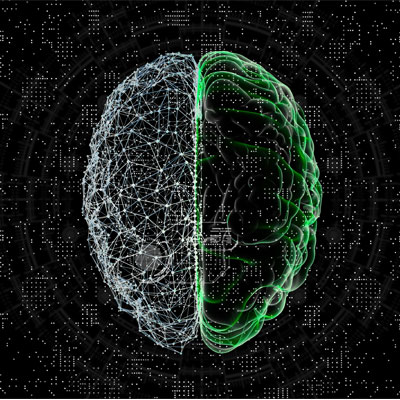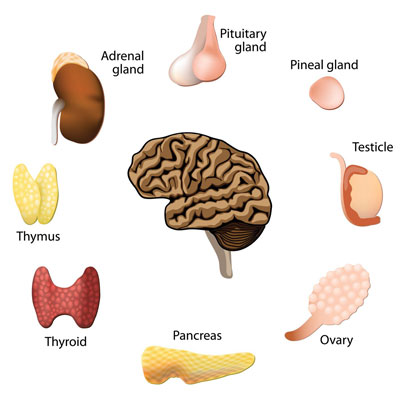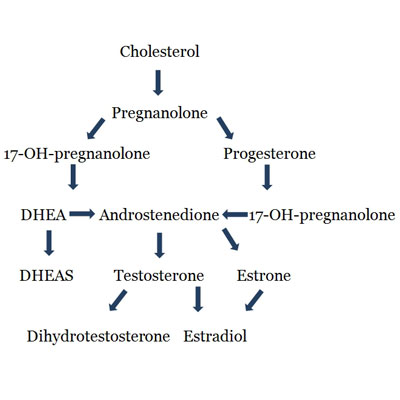Contents
- Synthesis of Steroid Hormones
- Where are steroid hormones produced?
- Mechanism of Action of Steroid Hormones
- The Androgens
- The Glucocorticoids
- The Mineralocorticoids
- The Oestrogens
- What are steroid hormones that fall under the classification of oestrogens?
- Steroid Hormones: The Progestogens
- Importance of Maintaining Steroid Hormones
Steroid hormones are fat-soluble hormones that fall into one of two classifications: corticosteroids and sex steroids. Trusted sourceWhat are corticosteroids?Cleveland ClinicGo to sourceCorticosteroids come from the adrenal cortex whereas sex steroids from the sexual organs such as the testes and ovaries.
Some of these chemical messengers are precursor hormones – meaning they have little biological effect on the body but are extremely powerful once converted into other hormones.
Some steroid hormones also exert influence on the nervous system and are referred to as Trusted sourceNeurosteroidsWhat is NeurosteroidsGo to sourceneurosteroids .
Steroid hormones can cross the blood-brain barrier and have both activational and organizational effects on the central nervous system (CNS). Neurosteroids regulate behavior, cognition, and mood in the CNS.
The types of steroid hormones in the human body include:
- Androgens
- Glucocorticoids
- Mineralocorticoids
- Oestrogens
- Progestogens
Under each category above you will also have a list of steroid hormones with detailed functions.
Synthesis of Steroid Hormones
The synthesis of steroid hormones (steroidogenesis) begins with a substance called cholesterol. Steroid hormones are derived from cholesterol in a series of chemical actions via biosynthetic pathways. It is essential to include a supply of healthy cholesterol in one’s daily diet to ensure enough of the precursor cholesterol for hormone production.
Steroid hormones are synthesized from a cholesterol precursor in one of the following ways:
- The uptake of low-density lipoprotein (LDL) cholesterol
- Cholesterol ester stores contained in intracellular droplets of lipids
- Cholesterol synthesized from acetate within a cell
Where are steroid hormones produced?
Steroidogenesis occurs in the tissues of the gonads and adrenal glands.
Various oxidative enzymes assist with the biosynthesis of steroid hormones along the pathway that begins with cholesterol. These enzymes are found in the endoplasmic reticulum and mitochondria. Free cholesterol enters the mitochondria from cytoplasm where it undergoes conversion into pregnenolone – the precursor to all steroid hormones.
The enzyme names and abbreviations are:
| Enzyme Common Name/Hormone Synthesized | Enzyme Abbreviation |
| Side-chain cleavage enzyme;desmolase: Pregnenolone | CYP11A1 |
| 3 beta-hydroxysteroid dehydrogenase: Progesterone, 17-hydroxy Progesterone, Androstenedione | 3 beta-HSD |
| 17 alpha-hydroxylase/17,20 lyase: 17-hydroxy Pregnenolone, Dehydroepiandrosterone (DHEA) | CYP17 |
| 21-hydroxylase: Deoxycorticosterone, 11-deoxycortisol | CYP21A2 |
| 11 beta-hydroxylase: Corticosterone, Cortisol | CYP11B1 |
| Aldosterone synthase: Aldosterone | CYP11B2 |
| 17 beta-hydroxysteroid dehydrogenase: Testosterone | 17 beta-HSD |
| Aromatase: Estrone, Estradiol | CYP19 |
| 5a-reductase | 5a-reductase |
Mechanism of Action of Steroid Hormones
Because steroid hormones are fat-soluble, they can pass through the phospholipid bilayer of cell membranes that prevent fat-insoluble molecules from entering. You can find steroid hormone receptors in the nucleus, cytosol, and plasma membranes of cells. The action of the steroid hormones can be either genomic or non-genomic.
Genomic action has two classes: type I receptors and type II receptors. Type I receptors in the cell cytoplasm have a heat shock protein (HSP) that is associated with a receptor that is inactive until it interacts with the ligand (steroid hormone). Type II receptors do not have HSP and are located in the nucleus of the cell.
Non-genomic action of steroid hormones does not depend on protein synthesis or gene transcription. An example of this is how steroid hormones induce rapid vasodilatation and neuronal survival in the cardiovascular system.
The mechanism of action of steroid hormones is as follows:
- The steroid hormone passes through the target cell’s membrane
- Each steroid hormone binds with specific steroid hormones receptors in the cytoplasm of the targeted cell
- The bound steroid hormone and receptor enter the nucleus and bind to a specific chromatin receptor (chromatin is the genetic material in the cell nucleus that contains DNA and proteins)
- After binding to the chromatin, the steroid hormone-receptor complex initiates a process called transcription that stimulates the production of messenger RNA molecules (mRNA)
- The mRNA molecules undergo modification and transport to the cytoplasm
- A process called translation next calls for the production of proteins which is used to build muscle
The transcription process influences gene expression or suppression in the cell.
The Androgens
Unlike non-steroid hormones, Trusted sourceAndrogens: Getting to know our hormonesClueGo to sourceandrogens largely regulate male characteristics, including the development of male sex organs. Synthesis of androgen hormones occurs primarily in the testes, ovaries, and adrenal glands. Females also require androgens, just in smaller amounts than males. Androgen hormones are crucial for sexual desire and arousal.
Although androgens are steroid hormones, they also function as paracrine hormones to support the production of sperm by the Sertoli cells.
Higher levels of androgen hormones are often associated with a leaner body. Lower androgen levels are frequently linked to fat storage.
Androgen hormones impact the brain due to the sensitivity of some neurons to steroid hormones. Extremely elevated androgen levels can lead to aggressive and risky behaviors.
A positive attribute of androgen hormones for pregnant women is their role in preventing premature contractions of the uterus.
Hormones in the androgen classification include:
- Androstenediol (A5) is a direct metabolite of DHEA and possesses potent estrogenic activity and is involved in gonadotropin secretion.
- Androstenedione (A4) comes from the testes, ovaries, and adrenal cortex. It is a precursor hormone to testosterone and estrone.
- Androsterone is synthesized from protein, and also occurs when the breakdown of androgens creates a chemical byproduct. It can be found in both the urine and plasma of females and males and has DHEA functions includeminor masculinizing effects.
- Dehydroepiandrosterone (DHEA) is a highly abundant hormone produced in the adrenal glands, and in lesser amounts by the ovaries and testes and targets androgen hormone receptors. It is a precursor hormone for testosterone and oestradiol (estrogen) production. DHEA provides the female body with about 75% of estrogens before menopause, and 100% after menopause.
DHEA functions include:
- As an androgen hormone: development of body hair, body odor, and pubic hair
- As a weak estrogen hormone: produces estrogenic effects after converting to estradiol in tissues such as the vagina
- As neurosteroids: exerts effects on the central nervous system
Dihydrotestosterone (DHT) is the result of the 5a-reductase enzyme conversion of testosterone. The formation of DHT occurs in the tissues of the seminal vesicles, prostate gland, hair follicles, epididymis, liver, skin, and brain.
DHT functions include:
- Development of male genitalia, prostate gland, and seminal vesicles
- Facial, pubic, and body hair growth
Testosterone is produced primarily in the testes in males and the ovaries in females and is considered to be the primary androgen hormone. A small amount of testosterone also comes from the adrenal glands. The targets of testosterone are the sex organs and androgen receptors. Testosterone has numerous functions, including:
- Development of male sex organs
- Sperm maturation
- Red blood cell production
- Libido support
- Bone density
- Muscle growth
- Brain functions
The Glucocorticoids
The steroid hormones definition of glucocorticoids is that of corticosteroids that bind to glucocorticoid receptors. Glucocorticoids, which come from the adrenal cortex, help regulate glucose metabolism and inflammation. As medicines, glucocorticoids aids in the treatment of allergies, autoimmune diseases, asthma, and sepsis. Glucocorticoids are the body’s primary stress hormones, and also suppress immune responses.
Cortisol is produced by the adrenal cortex and targets most tissues in the body. Functions of cortisol include:
- Regulation of blood glucose levels
- Anti-inflammatory actions
- Immune support – elevated cortisol alters immune system responses
- Blood pressure regulation
- Helps with stress
- Regulating metabolism and
- Suppressing digestive enzymes when elevated
- Too much cortisol can lead to Cushing’s syndrome
- Too little cortisol may contribute to Addison’s disease
- 11-deoxycortisol is the precursor hormone to cortisol.
- Corticosterone plays more of a role in birds and other animals and has only weak potencies in humans. It is more of a pathway to the production of aldosterone.
- Cortisone is a stress hormone that suppresses the immune system to reduce inflammation and pain at the site of an injury.
The Mineralocorticoids
Trusted sourceMineralocorticoidsScience DirectGo to sourceMineralocorticoids come from the adrenal cortex and regulate the body’s minerals such as hydrogen, potassium, and sodium. They balance the water in and around the cells, acting in the colon, kidneys, and salivary glands.
The mineralocorticoid steroid hormones list includes:
Aldosterone is produced in the adrenal cortex and targets the kidneys.
The functions of aldosterone include:
- Maintaining blood pressure levels by increasing blood volume
- Absorption of water and sodium
- Deoxycorticosterone is a precursor hormone to aldosterone and helps regulate electrolytes.
The Oestrogens
The Trusted sourceOestrogenHealth DirectGo to sourceoestrogens or estrogens are considered the primary female sex hormones. There are four types of estrogens in the female body, and three in males.
What are steroid hormones that fall under the classification of oestrogens?
Estradiol is the primary source of estrogen in the body and is produced mainly by follicles in the ovaries in women and the testes in men. The adrenal glands, liver, fat, the brain, and breasts also produce estradiol. Estradiol may come from aromatase conversion of estrone or testosterone. The enzyme aromatase which comes from belly fat initiates the conversion of testosterone into estradiol. Functions of estradiol include:
- Development of female secondary sexual characteristics such as breast development and widening of the hips
- Supports vaginal lining
- Increasing cortisol
- Reducing bone resorption
- Promoting lung functions
- Helps protect skin thickness and elasticity
- Has neuroprotective benefits for the brain
Estrone is primarily a precursor hormone to estradiol production and has weaker activity in the body. Elevated estrone levels may indicate type 2 diabetes in males. Increases during menopause and may contribute to cancer risk.
- Helps to protect the heart and brain
- Promoted nitric oxide production
- Protects blood vessel endothelial lining
- Neuroprotective following injury
Estriol is primarily synthesized during pregnancy by the placenta. Non-pregnant women have very low levels of estriol, and it clears rapidly from the bloodstream. It may also inhibit estradiol-induced proliferation of certain breast cancer cells. Estriol may also have gut healing and anti-inflammatory properties.
Estetrol is synthesized from estradiol and estriol during pregnancy by the fetal liver. Its role is mostly unknown, but it may have a limited impact on lipid metabolism, liver function, and bone and growth endocrine parameters.
Steroid Hormones: The Progestogens
Progestogens are classified as sex hormones, just like estrogens and androgens. They are not the same as progestins which are synthetic versions of progesterone, the most prevalent of the progestogens.
Pregnenolone is the precursor of all steroid hormones and is synthesized from cholesterol by the adrenal glands. It belongs to the neurosteroids group and is found in high concentrations in the brain. Pregnenolone may aid in memory and cognitive functions and protect against schizophrenia.
Progesterone is manufactured in the ovaries, testes, and adrenal glands. Pregnant women also produce progesterone in the placenta. Functions of progesterone include:
- Pregnancy support – maintenance of uterine lining
- Helps regulate menstrual cycle
- Nerve functions
- Anti-inflammatory
- Normalizes blood clotting
- Balances copper and zinc levels
- signaling of pancreatic function and insulin release
- Source hormone for testosterone
- Protects skin elasticity
- Protective effect on damaged brain tissue
- Has a regulatory effect on glial cells
17-Hydroxyprogesterone comes from progesterone and is most active during the third trimester of pregnancy.
Importance of Maintaining Steroid Hormones
Hormonal balance is crucial throughout life. Preserving the function of steroid hormones is vital to the maintenance of good health. As you can see by the chart in the synthesis section of this report, one hormone out of balance can have a spiraling impact on others.
Steroid hormones do more than influence sexual responses. They are crucial for metabolic, brain, immune, heart, and health functions. Steroid hormones help protect the bones, muscles, and more. For additional information, or for hormone testing, please contact our hormone clinic for a free consultation.
- Lautaro Zubeldia Brenner, PhD, Chuck Roselli, PhD, Sergio Recabarren, Maria Claudia Gonzalez Deniselle, Hernan E Lara
- Gisella Gargiulo, MD, PhD, Martin Sivori, Maria Meyer, Roberto E P Sica, Alejandro F. De Nicola, MD, Maria Claudia Gonzalez Deniselle
- Shailaja K Mani, PhD, Paul Mermelstein, PhD, Marc J Tetel, PhD, Gabriel Anesetti, MSc, PhD
- Gerald Litwack Ph.D
- Andrea Rodrigues Vasconcelos, João Victor Cabral-Costa, Caio Henrique Mazucanti, Cristoforo Scavone and Elisa Mitiko Kawamoto
- Jennifer P. Holst, MD, Offie P. Soldin, PhD, MBA, Tiedong Guo, MS, and Steven J. Soldin, MS, PhD, DABCC
Developmental and Functional Effects of Steroid Hormones on the Neuroendocrine Axis and Spinal Cord
Circulating Gonadal and Adrenal Steroids in Amyotrophic Lateral Sclerosis: Possible Markers of Susceptibility and Outcome
Convergence of Multiple Mechanisms of Steroid Hormone Action
The Role of Steroid Hormones in the Modulation of Neuroinflammation by Dietary Interventions
Steroid hormones: relevance and measurement in the clinical laboratory

